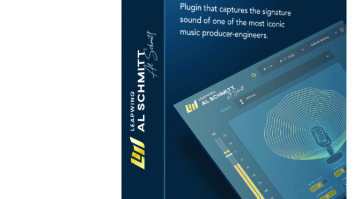
When British pro audio manufacturer Oram set out to build the GMS(Grand Master Series) Al Schmitt Pro-Channel compressor/EQ/preamps,mass-market appeal was not at the top of its list of design criteria.Renowned analog designer John Oram was intent on followingGrammy™-winner engineer Al Schmitt’s exact specs for the I/O andcontrols for the mic/line preamps, compressor and 6-bandquasi-parametric equalizer comprising the Pro-Channel. But as greatminds often think alike, critical engineers should find a lot to savorin this high-end, solid-state channel tailored for recording andmixing.
LAY OF THE LAND
The six-rackspace-high Pro-Channel is currently available only in asingle-channel configuration, although Oram promises a stereo versionwill soon follow. The unit’s sculpted front panel is gorgeous, and thelayout is thoughtful. The preamp and compressor sections are situatedto the left and right, respectively, of the unit’s VU meter, with theequalizer’s controls stretching across the width of the front panelbelow.
The Pro-Channel’s rear panel features three alternate mic/lineinputs on XLRs, a single XLR audio output and a multipin connector tolink to the unit’s external power supply. You’ll also findcontrol-voltage I/O jacks here; these TRS connectors provide sidechainaccess to the compressor section and can also be used to link two (ormore using parallel wiring) Pro-Channel compressors together. (The tipconnection carries the analog signal for sidechain applications, andthe ring connection carries the DC control voltage for linking.) Atwo-position switch alternately calibrates the front panel VU meter’s0VU reading to +4 or +14 dBu to better accommodate the system’s +28dBuheadroom. (The +14dBu setting only affects the meter’s post-EQ readingand not other meter source points, which I’ll discuss later.)
The rackmount unit connects to its beefy external power supply unitusing the included 9-foot multipin cable. The power supply unitprovides two multipin connectors for powering up to two Pro-Channels,although the supply delivers enough juice to drive at least five units.The power supply unit also features a detachable AC cord, a powerswitch and status LEDs for the power rails.
THE PREAMP SECTION
The Pro-Channel allows you to toggle between two preamps (you can’tuse both simultaneously): one, transformerless and the other,transformer-balanced. Either of these preamps can receive a single micor line input from any one of the three rear panel XLR connectors. Youcan connect three different mics, for example, to the XLRs and thenchoose each mic input in turn via a three-position rotary switch on thefront panel. This would allow quick and easy A/B/C mic comparisons orswitching between alternate vocal mics on verses and choruses.Unfortunately, the XLR inputs are nonlatching, inviting a cable to beinadvertently yanked out with phantom power applied. (Clientsoccasionally trip over cables in the control room!)
A 23-position, stepped gain control provides up to 70 dB of gain foreither preamp. Minimum gain for the transformerless pre is unity (0 dB)and 20 dB for the transformer-balanced pre. (The lowest five settingson the gain knob, which step you through the first 20 dB of gain, haveno effect on the transformer-balanced preamp.) Three red buttonsindependently activate phantom power for their respective XLR inputs,and a temporary Mute button kills audio output while switching phantompower on/off or switching among mic inputs or preamps. Another buttoninverts the phase of any XLR-input signal.
The Pro-Channel doesn’t offer a DI input for instruments, but Idon’t see this as a negative. In my experience, such add-ons rarely, ifever, sound quite as good as dedicated high-end DI boxes due tocompromises in impedance matching that result from users trying toadapt a DI input to circuitry that is optimized for mic input.
COMPRESSOR AND EQ SECTIONS
The Pro-Channel’s optical compressor follows the preamp section andcan be switched to be either pre- or post-EQ or completely bypassed. Acontinuously variable threshold control joins 11-step attack, releaseand ratio controls. Attack times range from 1 to 50 ms, and releasetimes from 0.05 to 4 seconds, with smaller increments of changeoccurring at the bottom of each range, as they should. Likewise, theratio control’s steps cover a 1.4:1 to 30:1 range with smaller jumps invalue at the bottom of its range, allowing for subtle tweaks. Aseparate 23-position control provides 0 to 22 dB of makeup gain, in 1dBincrements.
The Pro-Channel’s equalizer is a 6-band, quasi-parametric affair,with each band sporting its own frequency, boost/cut and bypasscontrols (the latter with status LEDs). A global bypass switch is alsoprovided for the entire EQ section. Sub (bass-frequency), Lo-Mid,Hi-Mid and Air (high-frequency) bell-response bands each offer a choiceof 23 center frequencies and up to 12 dB of boost/cut by way of23-position stepped controls. A black button for each of these bandstoggles the bell-curve response between 1/3-octave and 1-octavebandwidths. Separate low- and high-shelving filters are also provided,each offering a choice of 11 corner frequencies and the same(23-position, ±12dB) boost/cut controls as the bell-curvefilters.
The equalizer’s four bell-curve bands each provide a plethora offrequency choices but only minimal overlap between adjacent bands.Center frequencies range from 5 to 160 Hz for the Sub band, from 150 to2k Hz for the Lo-Mid, from 1 to 12 kHz for the Hi-Mid, and from 10 to32 kHz for the Air band. The low-shelving filter offers cornerfrequencies from 40 to 300 Hz, and the high-shelving filter from 6 to18 kHz. I wish the shelving filters offered slightly greater extremesin their frequency choices, but they should serve most applicationsexceedingly well.
Each of the six equalizer bands features a blue LED that glowsbrighter as in-band energy increases, or not at all if the energy fallsshort of the LED’s fixed threshold. Together, these LEDs serve as asimple spectrum analyzer that provides a visual aid in making EQdecisions. The LEDs light even when their associated bands and theentire equalizer section are taken out of circuit. Apparently, the LEDsare also influenced by each band’s filter controls, as they vary inbrightness as you change gain and frequency settings. Nice!
The only major omission for the equalizer section is a master outputlevel control. Lacking this feature, A/B (i.e., EQ In/Out) comparisonsare difficult to make and final gain-stage adjustments (when thecompressor is placed pre-EQ) are problematic. I also occasionallymissed having lowpass and highpass filters to work with in the EQsection while recording vocals and bass guitar.
The Pro-Channel’s VU meter can be alternately switched to show theaudio signal’s level at the preamp output, compressor input, compressoroutput or main (post-EQ) output. Alternatively, the meter can beswitched to show the compressor’s gain reduction. An Inset Trimcontrol, located just below the meter, provides ±2 dB of meteradjustment to recalibrate the gain-reduction readout to 0 dB when nosignal is present.
IN USE
The Pro-Channel’s knurled control knobs have a great feel and theirdetents oblige repeatable settings, but their hash marks are difficultto see when viewed at an angle or in low light. Titling for incrementalfrequency and gain settings (the latter for both the EQ and mic pre)are spaced close together, making it difficult to ascertain whatposition the associated control knobs are set to. I often found myselfcounting the number of detent clicks when setting these controls torepeat former settings. That said, the controls’ wide range andplentiful adjustments are precisely what make them so useful forexacting tracking and mixing applications.
In an A/B test recording acoustic guitar with a spaced pair of DPA4011 mics and Apogee Rosetta A/Ds, the Pro-Channel’s transformerlesspreamp sounded virtually identical to my Millennia HV-3D/8. The soundwas open and detailed, and the track exhibited an ultrasmooth spectralbalance and outstanding depth. In comparison, the Pro-Channel’stransformer-balanced preamp brought upper mids and low highs moreforward. I loved the added presence and subtle saturation that thePro-Channel’s transformer-balanced preamp lent to vocals and drums. Forrecording delicate acoustic instruments, I preferred using thetransformerless pre.
The Pro-Channel’s optical compressor sounded warm, completelytransparent and fluid on vocals and bass guitar. With moderate attackand release times employed, it even handled steel- and nylon-stringguitars without pumping. Considering its optical design, I was alsosurprised by how much the Pro-Channel’s compressor could make a snaredrum track pop. Another plus: The unit’s VU meter shows would-be gainreduction even with the compressor bypassed, allowing you to dial inreasonable settings in front of clients before activating thecompressor.
The Pro-Channel’s EQ allows only broad tonal shaping and not thesurgical notching that a true parametric design affords. That said, Ialways found it to be very responsive, musical and sweet-sounding.
CONCLUSIONS
Besides the omission of a master output-level control for the EQsection, my main complaint about the Pro-Channel’s feature set is thatthere are no direct inputs or outputs for the compressor and equalizer.As it is, if you want to use an alternative preamp with thePro-Channel’s compressor or EQ, then you’ll have to suffer theadditional amplifier at the Pro-Channel’s input. At a list price of$8,525 ($16,430 for the stereo unit), I’d like to see more flexibility.Of far less concern is the cursory nature of the owner’s manual, whichis vague on some points of operation.
On the plus side, the Pro-Channel sounds truly excellent. Andservice-oriented Oram goes the extra mile for its customers, keepingits office open throughout both European and U.S. business hours. ThePro-Channel’s price tag puts it out of reach of most small studios, butthe unit’s impressive sound and superior build quality make it veryworthy of consideration by those who can afford it.
Oram, 011-44-1474-815300, www.oram.co.uk.
Mix contributing editor Michael Cooper is the owner of MichaelCooper Recording, located in beautiful Sisters, Ore.







